
OPENING HEARTS AND BRIGHTENING SMILES.
Guatemala is a land of wonder: a strikingly beautiful country both in geographical features and cultural landmarks. In this Central American nation (about the geographical size of Ohio), there are lush green rainforests, cone-shaped active volcanoes enveloped in misty clouds, bathtub-warm aqua-blue water bordered by sparkling white sand beaches, and ancient stone pyramids constructed many centuries ago by a once-prosperous and advanced civilization. Yet even though Guatemala is overflowing with a vast richness of physical beauty, it is a land of dichotomy. Guatemala is one of the poorest countries on the globe and is greatly struggling to meet the basic needs of its people.
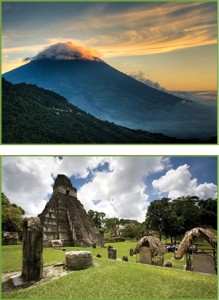 As of April 2014, the United Nations World Food Programme listed on its website that 53 percent of Guatemalans live below the poverty line, with 13 percent of the people living in extreme poverty. In addition, according to statistics found on the Central Intelligence Agency (CIA) World Factbook website in the same month, Guatemala has the largest population of any Latin American country and almost half of the population is under the age of 19. Naturally, along with this very young population comes a host of problems—child labor, poverty and malnutrition are chief among them.
As of April 2014, the United Nations World Food Programme listed on its website that 53 percent of Guatemalans live below the poverty line, with 13 percent of the people living in extreme poverty. In addition, according to statistics found on the Central Intelligence Agency (CIA) World Factbook website in the same month, Guatemala has the largest population of any Latin American country and almost half of the population is under the age of 19. Naturally, along with this very young population comes a host of problems—child labor, poverty and malnutrition are chief among them.
Twenty-one percent of Guatemalan children ages 5 to 17 years (a total reaching nearly one million) are engaged in some type of child labor: be it out in the fields planting and harvesting crops, working long hours in manufacturing, or hunting through garbage at the city dump in an attempt to find any type of usable scrap that can be traded or bartered for money. In addition to the sometimes horrid living and working conditions, this country has the fourth-highest malnutrition rate in the world for children under the age of five years.
As expected with Guatemala’s extreme poverty, the health-care system is also severely lacking. The website for the CIA World Factbook in April 2014 estimates that there is less than one physician available for every 1,000 people in Guatemala and only 0.7 hospital beds are available for the same number of people. Most people are so poor that even if medical facilities and physicians were readily available, they wouldn’t have the funds to pay for the services and would still likely go untreated. Because of the inadequate services and the lack of funds, many Guatemalans suffer from pain, infection and various other maladies that could easily be alleviated with access to basic medical care.
Making a Difference
Guatemala’s dire circumstances are a magnet for medical professionals from around the world. Every year, hundreds of professional medical teams and pre-professional medical students travel to the emerald-green rainforests of this Central American country to offer their services as part of a global humanitarian effort. Medical teams do basic examinations and provide necessary treatments. Surgical teams repair birth defects like cleft lips and palates. And dental teams perform a variety of procedures in critical, emergency, and preventative care.
Tooth decay is a huge problem in Guatemala and is attributed to several factors, including no basic personal dental hygiene, lack of access to fluoridation, poor diet, and easy access to foods and drinks with high-sugar content. Therefore, dental teams that embark on service trips to the country often perform hundreds of extractions, root canals, fillings and cleanings on each visit.
Dentists generally go for at least a week, pay for travel expenses, bring portable equipment and supplies, and often traverse all kinds of terrain as they move from place to place within the country. Some visitors prefer to stay in well-known American chain hotels in tourist areas while others choose to rough it in less-frills motels and even portable tents. Some dentists work in medical clinics constructed by international humanitarian groups and nonprofit organizations. Other dentists set up shop in churches and community centers. Dentists who travel to the mountain villages or the inner rainforest generally find conditions so primitive that they often perform procedures in tents, lean-tos or even the great outdoors.
Each medical team has its own reasons for serving in Guatemala. Some go as a way to “give back” and make the global community a better place. Others go to make a difference in the lives of others and help people who are in dire need. Still others go to have a life-changing experience and use their talents in a meaningful way. Regardless of the reasons that individuals go, rarely does anyone depart from a Guatemalan medical service trip without having their expectations abundantly fulfilled.
Of course, the best way to find out what it’s really like to participate in a dental service trip is to read the stories of the people who have already experienced it. To give you an idea of what dental humanitarian trips are like in the country of Guatemala, the editorial team at Aesthetic Dentistry sought out and interviewed three different dentists or dental teams. These individuals have all been on numerous trips to Guatemala, some—in fact—have more than a decade of humanitarian work experience in this country. Here are their stories.
Decades of Service
Dr. James McHenry, of Dental Arts in Plymouth, Michigan, has been on 20 dental service trips since 1988. In addition to visiting Guatemala a total of 15 times, McHenry has traveled to such places as the Amazon Jungle in southern Columbia, El Salvador, the Dominican Republic, Moldova in Eastern Europe, and the Andes of Peru. Some of these places were so remote and primitive that he felt like they were “straight out of National Geographic.”
McHenry explained why he has visited Guatemala numerous times: “I was drawn to this particular location because there was a missionary family from my church who had dedicated their lives to living among the Mayan people in the mountainous region of this country.” McHenry said, “When the missionaries first arrived there, the people of this particular tribe were on the verge of extinction. They were living in stick huts with dirt floors. They had no electricity, so they cooked over an open fire inside their huts. They essentially had no protein in their diets and subsisted off a little corn and wild roots. They had no access to clean water. The only water they had was run-off water, and because of that, many were dying from diseases like diphtheria and cholera. The missionaries were committed to improving the people’s lives in every way that they could.” McHenry added, “And I wanted to do my part to help them out. I have come back year after year to do that.”
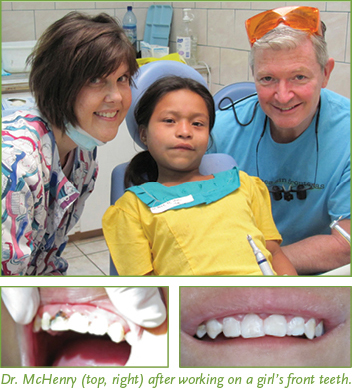 At the beginning of his travels, McHenry worked directly in the villages—performing most of his procedures outside with portable equipment. But about 10 years ago, a Rotary International club provided the funds to build a small cinder block clinic in the area. Now, on each visit to Guatemala, McHenry performs most dental procedures at the clinic, including extractions, fillings, and bondings—particularly on the front teeth.
At the beginning of his travels, McHenry worked directly in the villages—performing most of his procedures outside with portable equipment. But about 10 years ago, a Rotary International club provided the funds to build a small cinder block clinic in the area. Now, on each visit to Guatemala, McHenry performs most dental procedures at the clinic, including extractions, fillings, and bondings—particularly on the front teeth.
In the villages, the missionaries would encourage the young women, who were near the age of marriage, to receive dental treatment. Many of the young women had black or discolored teeth. “We would get the decay out and then bond the teeth to make them look the best we could for our limited time and conditions,” McHenry explained. “It was so rewarding to see the joy on the young ladies’ faces when they looked in a mirror and realized that their teeth were no longer discolored and decayed. Many would start crying or laughing when they saw their improved, white smiles. They actually showed their teeth instead of hiding them with their hands or their lips. The procedures literally saved these young women’s chances of getting married, which meant everything to them and their future in the villages.”
In addition to his clinic work, McHenry typically travels to two or three outlying villages to perform dental procedures. To access the villages near Belize (about three hours to the east of the missionaries’ clinic), he would cross a “nasty, snake-filled swamp.” McHenry explained, “We’d be up to our hips sometimes in mud carrying all of our supplies and equipment. It was just so hard getting to people sometimes, until fortunately, at one point an outreach group from our church built a 300-yard bridge across the swamp. This made transport so much easier and with the improved access we have been able to help even more people there.”
Usually, McHenry goes on a 10-day trip to Guatemala once a year. After accounting for travel days, he’s able to put in five full days of dental work. In Guatemala, a typical work day for McHenry starts at eight or nine in the morning and lasts until ten at night. “I honestly don’t count the number of people I see every day,” McHenry explained, “but it’s probably around 30 or so, depending upon the procedures I need to perform. I usually try to work as quickly as possible to see as many people as I can before I have to leave for the next village.” By the end, he’s both exhausted and energized and ready to come back another year.
McHenry Photo Gallery Click Here.
One Trip Was All It Took
The husband-and-wife team of John and Terri Bauer and their son, Cody, of Mansfield Family Dentistry in Mansfield, Texas have collectively been in the dental industry for 40 years. John and Cody are dentists and Terri is a dental hygienist. In 2013, the Bauers had an opportunity with their
church to participate in a mission trip
to Guatemala. They planned on putting their 40 years of experience to good use in this country by helping out with the people’s dental needs.
One of the Bauers’ favorite experiences involved a young child who came in for dental work on that first trip. The child was around eight or nine years old. He was blind, unable to speak and had almost completely lost his hearing. “The mother begged us to help him. His teeth were in awful condition. One was totally infected and the child was clearly in pain,” Terri explained. “Just imagine how frightening this must have been for a child in this condition to be treated by a dentist for the very first time. I closed my eyes and imagined what it must have been like for this child sitting there in his dark and quiet world and I felt so bad for him,” Terri said.
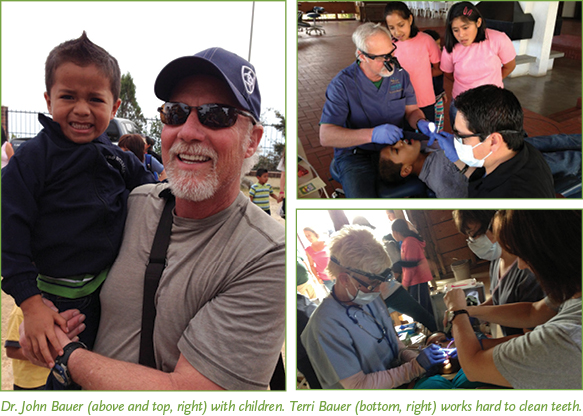 Dr. John knew that he couldn’t perform the extraction on the child unless the team could get the child to remain still. “We tried everything we could,” Terri explained further. “There simply was no holding this child down. Dr. John told us later that it was at that point that he said a quick prayer in his mind. Then, immediately, for just a moment, the child—while holding on to the hand of his younger brother—was able to hold still long enough for Dr. John to extract the tooth. To this day, Dr. John still says that he has never pulled a tooth so fast in his entire career. He felt the hand of God guiding him as he performed the procedure,” Terri said. “We all cried when we were done. This experience was so rewarding for us. Just helping this one child made our entire trip worth it.”
Dr. John knew that he couldn’t perform the extraction on the child unless the team could get the child to remain still. “We tried everything we could,” Terri explained further. “There simply was no holding this child down. Dr. John told us later that it was at that point that he said a quick prayer in his mind. Then, immediately, for just a moment, the child—while holding on to the hand of his younger brother—was able to hold still long enough for Dr. John to extract the tooth. To this day, Dr. John still says that he has never pulled a tooth so fast in his entire career. He felt the hand of God guiding him as he performed the procedure,” Terri said. “We all cried when we were done. This experience was so rewarding for us. Just helping this one child made our entire trip worth it.”
One trip was all it took for the Bauers to be hooked on dental humanitarian work. “We were so moved by our experience in Guatemala,” Terri explained, “that we just had to go back. When you’re there, you almost feel like never leaving. The people are just so grateful for anything that you do for them. Many of the teens and adults have never had their teeth cleaned in their entire lives. Afterwards, they look at their teeth in the mirror and it changes the way they view themselves.”
Upon their return home, the Bauers immediately planned another trip, and then another. In 2013, they went on a total of three trips to Guatemala and in 2014, they are planning the fourth and fifth trips. The Bauers even started a nonprofit organization called Professional Response, which will help other dentists get involved with service work for the Guatemalan people.
After the first trip, the Bauers knew that this type of experience would be the best team building opportunity they could offer to their staff. So while some of their team stays in Texas and maintains the office, the others go on the trip and then the roles are reversed for the next trip. They also bring along other dentists and their teams, too, so they can combine forces, make the trips more productive and also learn from each other. “We stay in a variety of locations when we visit Guatemala,” Terri explained. “Sometimes we stay in the villages or orphanages and other times we stay in hotels and travel back and forth in vans to the locations where we help our patients. After working hard all day, we enjoy spending time together in the evenings. This time is a critical component of our trip. It’s an opportunity for everyone to get to know each other better and also reflect on some of the day’s experiences. These humanitarian missions have really helped to unify our team. They have also helped each staff member know that they are part of an organization that truly changes lives through dentistry.”
Being involved in humanitarian dental work has been life-changing for the Bauers. “These experiences have helped us grow closer together as a family and as a dental practice. The people in Guatemala do not have any sense of entitlement whatsoever. They are just so grateful for anything and everything they have and that attitude has helped transform the way we look at life, too. It helps us be more grateful for what we have in our lives as well,” Terri explained.
Bauer Photo Gallery Click Here.
Changing the World, One Smile at a Time
Dr. David Prince of Prince Dental Group in Midway, Utah was a third-year dental student when his father approached him with the idea of going on a humanitarian dental trip with the Hirsche Smiles Foundation. The Hirsche Smiles Foundation (HSF) is a nonprofit organization that brings plastic surgery and dental teams to underprivileged areas in Guatemala. HSF has three components: one focuses on surgical procedures (like cleft lips and palates), one focuses on construction projects (like building clinics and digging wells), and one focuses on dentistry. All three parts of this foundation are like cogs in a wheel and help the entire organization run smoothly.
Prince accepted the offer to go on that trip and afterwards he found that getting involved with humanitarian service while in dental school was extremely helpful in many ways. First, it helped him gain a tremendous sense of compassion and empathy for his patients. Second, it helped him attain some practical clinical skills. Prince explained, “On one trip alone, we performed more than 200 extractions and most dental students are only required to do 20 to 25 extractions in order to graduate.”
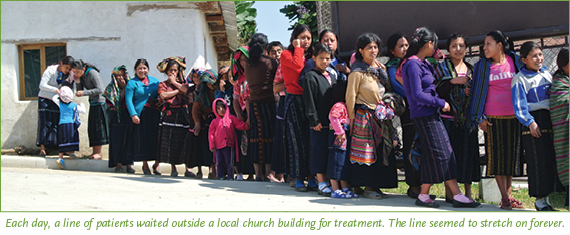 During Prince’s fourth year in dental school, he encouraged fellow dental student Nate Lester (who is now Dr. Nathan Lester of Bear River Dental in Evanston, Wyoming), to sign up for the service trip, too. “We did all sorts of odd jobs to raise the money,” Prince explained. “We participated in various university research studies that paid us money for our involvement. We also mowed lawns. In addition, I received a scholarship at the eleventh hour that equaled what I needed in order to go on the trip,” added Lester.
During Prince’s fourth year in dental school, he encouraged fellow dental student Nate Lester (who is now Dr. Nathan Lester of Bear River Dental in Evanston, Wyoming), to sign up for the service trip, too. “We did all sorts of odd jobs to raise the money,” Prince explained. “We participated in various university research studies that paid us money for our involvement. We also mowed lawns. In addition, I received a scholarship at the eleventh hour that equaled what I needed in order to go on the trip,” added Lester.
Since that first trip together in 2005, Prince and Lester have become a team. They travel to Guatemala once a year, often with their wives, to help out the HSF. They have now been on a total of nine service trips together. On the most recent trip in early March 2014, Prince and Lester scheduled eight days away from their practices in order to spend five “very long days” performing dental procedures.
In Guatemala, Prince and Lester treated patients in a local church building. Each day, the line of patients outside the church just seemed to stretch on forever. They worked as quickly and efficiently as they could. After five full days, the four dentists on the team cared for a total of 930 patients, performed 1,769 extractions, and completed 179 fillings. This was their best trip ever, in terms of performance. “We worked our guts out,” Prince said. “By the end, our hands were killing us and we had blisters across our fingers. We worked as hard and as fast as we could, so we had to turn away as few people as possible.”
One of their favorite memories involved an elderly lady who came in with serious oral health issues. “Her mouth was so infected that we had to extract all 25 teeth that were left in her mouth,” Lester explained. It might sound like a horrifying experience to have all of the teeth in your mouth extracted, but this woman was so grateful not to be in pain anymore that she was glad to have them gone. Lester said, “After the procedure, she returned later in the day. She had a basket on her arm and inside was one chicken egg. It was probably all she had, and she wanted me to have it. She presented it to me like it was the greatest treasure on earth, kissed me on the cheek, and went on her way (see photo, bottom left). That memory will stay with me forever.”
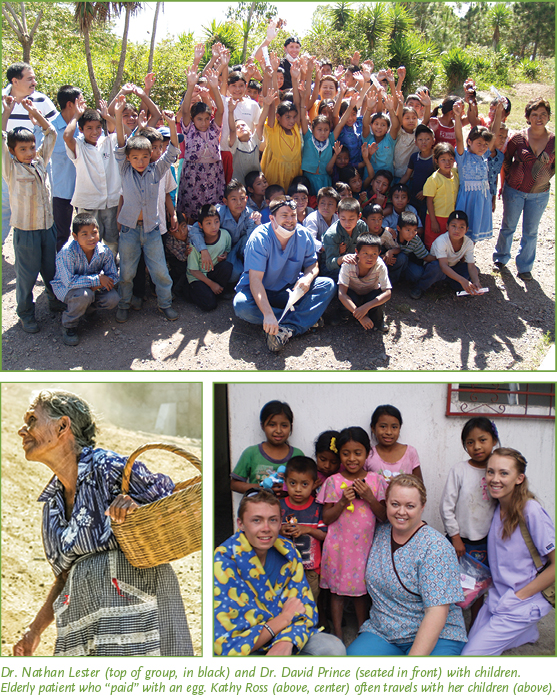 Along with Drs. Prince and Lester, Kathy Ross volunteers with HSF. She is the Director of the Dental Service Team and often volunteers as a dental assistant when she travels with teams to Guatemala. Ross became involved as a dental assistant with HSF long before the dental portion of the foundation existed. Ross’s son Tyler was born with a cleft palate and Dr. Blayne Hirsche was the surgeon who performed his reconstructive surgery. Every time Ross brought Tyler in for an appointment, Dr. Hirsche would talk about Guatemala and the number of cleft palate cases that he would see in that region. She asked Dr. Hirsche more about the foundation and decided to get involved. Ross explained, “I had so many resources at my fingertips when Tyler was born, but it was still very difficult and stressful for me to handle everything associated with his situation. I couldn’t even imagine how difficult it must be for a mother to deal with these same issues in a place without any medical care. I knew I had to go and help however I could.”
Along with Drs. Prince and Lester, Kathy Ross volunteers with HSF. She is the Director of the Dental Service Team and often volunteers as a dental assistant when she travels with teams to Guatemala. Ross became involved as a dental assistant with HSF long before the dental portion of the foundation existed. Ross’s son Tyler was born with a cleft palate and Dr. Blayne Hirsche was the surgeon who performed his reconstructive surgery. Every time Ross brought Tyler in for an appointment, Dr. Hirsche would talk about Guatemala and the number of cleft palate cases that he would see in that region. She asked Dr. Hirsche more about the foundation and decided to get involved. Ross explained, “I had so many resources at my fingertips when Tyler was born, but it was still very difficult and stressful for me to handle everything associated with his situation. I couldn’t even imagine how difficult it must be for a mother to deal with these same issues in a place without any medical care. I knew I had to go and help however I could.”
Ross has been going on service trips to Guatemala for 17 years. “I was even there in the village when the conversation happened about starting the dental team,” she stated. “I just love serving the people of Guatemala. Every time I go, I feel like I’m going home to my people.” Ross’s advice to dental teams who have had humanitarian experiences is simple: “Share your experiences with others so they can feel inspired and want to get involved, too. I would likely have never gotten involved with service work like this if I hadn’t been introduced to it by Dr. Hirsche years ago. I’m so glad he shared that with me. The experiences I’ve had in Guatemala have truly changed my life.”
Hirsche Smiles Foundation Photo Gallery Click Here.
Deciding to Make a Difference
There’s a world of work still to be done in Guatemala—millions of people are waiting for even the most meager amount of help. While one person certainly can’t help everyone, the adage of “many hands make light work” definitely rings true. Every little bit of help that someone can offer definitely makes a difference. If dentists are unable to go on these trips themselves, they can alternatively donate funds, supplies, and humanitarian kits to worthwhile organizations.
Because of all of their rewarding experiences, the dentists interviewed in this article unanimously agreed that they would whole-heartedly recommend humanitarian service experiences to their fellow dentists. Dr. James McHenry summed it up best: “Find the right venue for you. There are many opportunities locally, on the other side of the world, and everywhere in between. All you have to do is open your eyes and look. I don’t think you’ll ever be disappointed or think you shouldn’t have done it. You’ll be glad you did. In most cases, I think dentists have an awful lot to be thankful for. You have to realize that it could have been you born out there in the types of conditions these people are living in. If this was your life, you would want someone to come and help you.”









